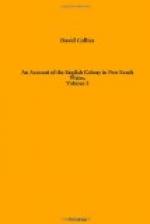From the situation of the sloop at this anchorage, Glass-House-Bay seemed to be closed round, except at one small opening which bore S 27 degrees E. To turn up this opening, they got under sail as soon as the ebb tide slacked. On standing near the south part of the shoal that appeared to surround the island to which the natives had retired, one of them came down abreast of the sloop, making the same gestures, and running backwards and forwards, as others had done before; but little attention was paid to him, Mr. Flinders being more intent on getting as far up the bay as possible while the tide favoured him. A little before midnight he was obliged to anchor, finding that the deep water had contracted into a narrow channel.
On the following day Mr. Flinders landed upon an island that lay in his passage, with instruments for taking angles, and observing the latitude. Footsteps of dogs, and those recent, were numerous upon the beach; but traces of men were scarcely visible: there were, however, several fire-places, and many other marks of the island having lately been visited. This island was two or three miles in circumference. The central part was higher than the skirts, and was covered with a coat of fine vegetable mould of a reddish colour. On the SE side of the island this elevated part descended suddenly in a steep bank, where the earth was as red as blood; and, being clayey, some portions of it were nearly hardened into rock. The trees upon it, among which was the new pine, were large and luxuriant. The exterior part of the island upon the west side was a flat, over which the tide seemed to rise, and was abundantly covered with large mangrove trees. On the SW and NE sides it was mostly low and sandy, and here the palm nut tree was produced. Probably these nuts formed the principal inducement for the natives to visit this island; and there was abundant testimony under the trees that they were not suffered to fall off and rot. They met with some boughs so ranged as to keep off the southerly winds; and from the fireplaces which they were placed to defend, it was inferred that not less than five or six natives had made this their place of residence, probably a temporary one only, as they did not meet with any huts regularly constructed.
The black and the white cockatoo, the beautiful lilac-headed paroquet, and the bald-headed mocking bird of Port Jackson, were seen here; but there were not any marks of resident quadrupeds, rats excepted.
The latitude of this island, deduced from the sun’s altitude taken at noon, was 27 degrees 34 minutes 59 seconds S making the depth of this bay, from Cape Moreton, to be thirty-four miles; for beyond this island the bay was contracted into a river, of considerable width indeed, but it appeared to be so shoal, or, if there was any deep channel, to be so difficult of access, that Mr. Flinders gave up all idea of pursuing it further, especially as the winds were obstinately adverse: he therefore returned on board, with the intention of running into the river near the Glass House peaks, there to lay the sloop on shore, and procure a supply of fresh water, if a convenient situation could be found.




